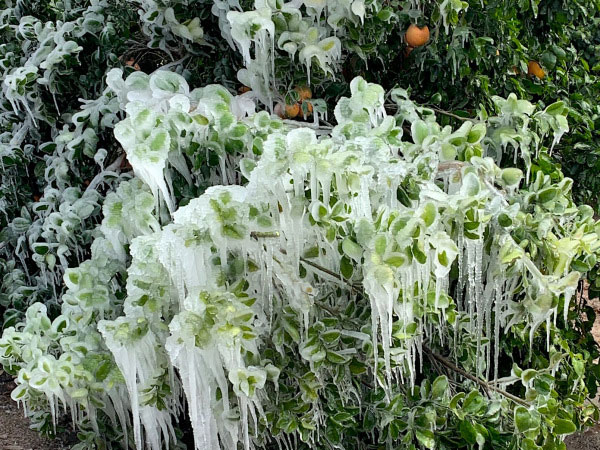Cold snap deep in Texas almost certainly means crop losses for citrus growers
Feb 17, 2021Crop losses that are suffered will come after a weather disaster took a $100 million bite out of the state’s citrus industry last July. The industry was hit hard by Hurricane Hanna, which was the first hurricane of a hyperactive 2020 season and made landfall in late July near Port Mansfield, Texas.
The historic cold snap that has frozen Texas this week with brutal winter weather and brought snow all the way to beaches along the Gulf of Mexico is also bringing headaches for citrus growers at the southern tip of the state.

According to the USDA, Texas is the nation’s third-largest citrus-producing state behind California and Florida. Dale Murden, president of Texas Citrus Mutual, a trade group that represents the interests of citrus growers in the state, told AccuWeather by email that growers were “about 50% harvested to date on grapefruit,” when the brutally cold weather hit early this week, and were “just beginning to harvest our late Valencia orange.”
“Most everyone saw temps of 21 degrees for several hours,” Murden, who also is a grower, said. “We will no doubt lose some of the crop as we are seeing some ice buildup inside the fruit.” Murden said that when temperatures dip below 28 degrees and stay below that mark for five hours or longer, the fruit that is still on branches begins to freeze on the inside.
Citrus groves in Texas are largely situated in the Lower Rio Grande Valley in parts of Hidalgo, Cameron and Willacy counties, Murden said. Several groves are located in Mission, a city of about 85,000 that is situated about 240 miles south of San Antonio, right along the border with Mexico. “Come and enjoy the warm weather,” the city says on its website.
Texas grapefruit trees encased in ice after a winter storm hammered the state with record cold. (Dale Murden)
And, usually, the weather is warm there. In fact, just as recently as Wednesday of last week, the high temperature in Mission reached 85 degrees, which is more than 10 degrees above average for this time of year. By Friday, though, the temperature had crashed to a high of just 43, with a low in the 30s. And it only went down from there, bottoming out with an overnight low of 22 degrees on Feb. 15 as Arctic air continued pushing southward.
It wasn’t just the unseasonable cold that was causing problems for growers. The wind also foiled growers’ attempts to protect the fruit. “The wind was blowing so hard” on Sunday night, Murden said, that “most measures to warm trees up couldn’t work.”
April Flowers of Lone Star Citrus, a grower based in Mission, said there are a few different methods growers use to protect crops. “Some growers use a micro-jet irrigation system to spray their trees with water prior to the freeze because ice is insulative at 32 degrees,” Flowers said, “but this type of system is expensive and not widely used.”
Source: AccuWeather Global Weather Center
Similar Stories

December 2024 U.S. Transportation Sector Unemployment (4.3%) Was the Same As the December 2023 Level (4.3%) And Above the Pre-Pandemic December 2019 Level (2.8%)
View ArticleDP World appoints Jason Haith as Vice President of Freight Forwarding for U.S. and Mexico
DP World, a global leader in logistics and supply chain solutions, has announced the appointment of Jason Haith as Vice President, Commercial Freight Forwarding – U.S. and Mexico, effective immediately.…
View Article
Amaero secures final approval for $23.5M loan from Export-Import Bank
View ArticleU.S. Bureau of Labor Statistics employment situation
Total nonfarm payroll employment increased by 256,000 in December, and the unemployment rate changed little at 4.1 percent, the U.S. Bureau of Labor Statistics reported today. Employment trended up in…
View ArticleImport Cargo to remain elevated in January
A potential strike at East Coast and Gulf Coast ports has been avoided with the announcement of a tentative labor agreement, but the nation’s major container ports have already seen…
View ArticleS&P Global: 2025 U.S. transportation infrastructure sector should see generally steady demand and growth
S&P Global Ratings today said it expects activity in the U.S. transportation sector will continue to normalize in 2025, with growth rates for most modes of transportation slowing to levels…
View ArticleGet the most up-to-date trending news!
SubscribeIndustry updates and weekly newsletter direct to your inbox!





